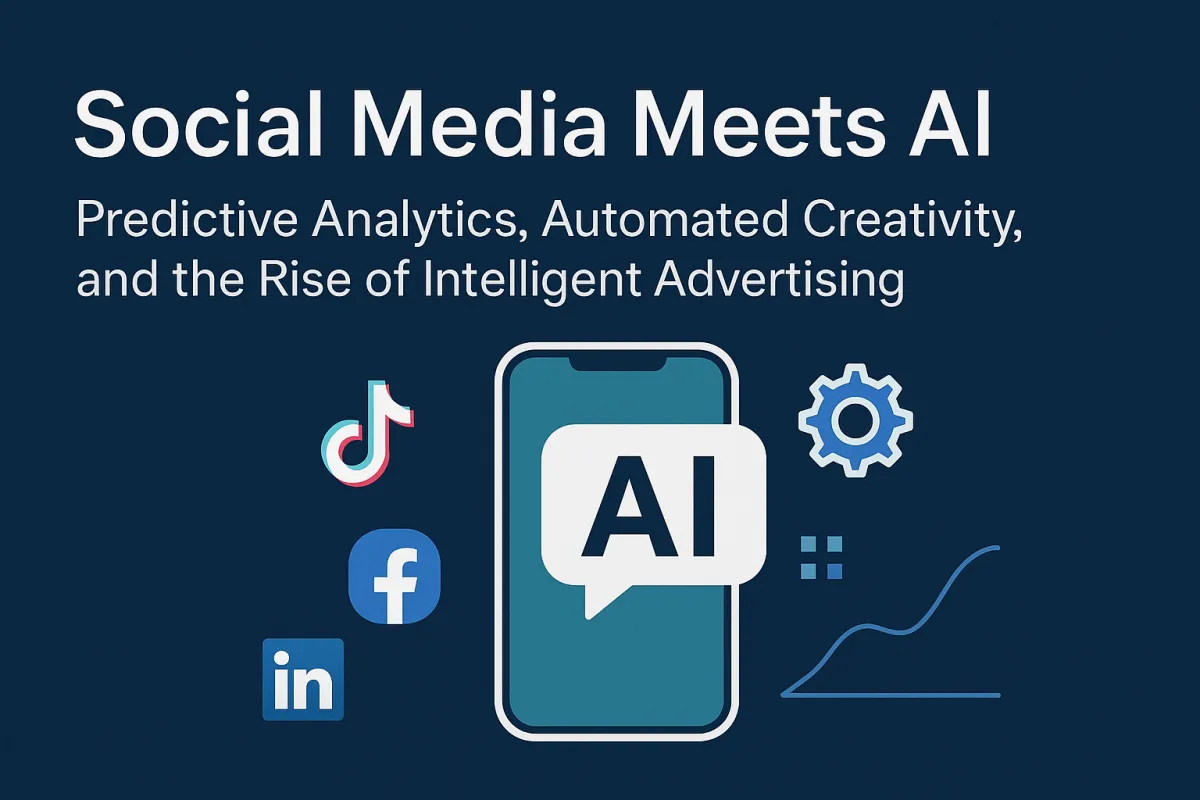
Social Media Meets AI: Predictive Analytics, Automated Creativity, and the Rise of Intelligent Advertising
The integration of artificial intelligence (AI) into social media marketing has transformed how brands connect with audiences, optimize campaigns, and measure success. What began as simple automation tools has evolved into intelligent systems capable of predicting behavior, generating content, and personalizing engagement at an unprecedented scale.
From predictive analytics to automated creativity, AI is revolutionizing digital marketing — making it smarter, faster, and more human than ever before.
The Evolution of AI in Social Media Marketing
From Scheduling Tools to Intelligent Systems
A decade ago, AI’s presence in social media marketing was limited to basic scheduling platforms and sentiment analysis tools. Today, the technology has matured into a strategic powerhouse, capable of understanding consumer intent, anticipating trends, and optimizing ad performance in real time.
Platforms like Meta, LinkedIn, TikTok, and Google have integrated AI deeply into their ad systems — automating targeting, bidding, and creative testing to deliver the right message to the right audience at the right time.
This evolution has fundamentally changed the marketer’s role, shifting focus from manual execution to strategic oversight and creative innovation.
Predictive Analytics: Anticipating Customer Behavior
Turning Data into Foresight
At the heart of AI-driven marketing lies predictive analytics — the use of historical and real-time data to forecast future actions. By analyzing user behavior, interests, and interaction patterns, AI tools can predict what type of content or product will resonate most with a particular audience segment.
For instance, AI models can determine which users are likely to engage with a new product ad or which customers are at risk of unsubscribing. These insights allow brands to adjust strategies proactively, leading to better targeting, reduced ad spend, and higher ROI.
Practical Applications Across Platforms
Meta (Facebook & Instagram) uses AI to predict the best time to show ads for maximum engagement.
LinkedIn leverages predictive models to identify high-intent users for B2B campaigns.
TikTok’s recommendation algorithm uses deep learning to anticipate what users want to see next, helping brands ride the wave of viral content trends.
Predictive analytics doesn’t just help marketers react — it empowers them to anticipate audience needs before they arise.
Automated Creativity: When AI Designs the Message
AI as the Creative Partner
AI has moved beyond analysis — it’s now creating. Through generative AI tools, marketers can produce ad copy, visuals, and even videos automatically based on campaign goals and audience profiles.
Tools like Meta’s Advantage+ Creative, Google’s Performance Max, and Canva’s Magic Studio allow advertisers to generate multiple creative variations that are tested and optimized in real-time. This not only saves time but also helps discover unexpected creative combinations that drive engagement.
AI-generated content is now capable of matching human tone, emotional cues, and brand voice — blending data science with creativity.
Balancing Automation with Authenticity
While AI can generate high-performing creatives, maintaining authenticity remains critical. Audiences are becoming more adept at spotting automated content. Successful marketers use AI as a collaborative partner, not a replacement — refining AI-generated ideas to reflect brand personality and genuine human connection.
The Rise of Intelligent Advertising
AI-Powered Targeting and Optimization
Intelligent advertising refers to ad systems that learn and optimize continuously. Instead of relying on static campaign settings, AI-driven platforms use real-time data to adjust targeting, bidding, and placements automatically.
For example:
Google’s Performance Max campaigns analyze search trends and user intent signals to show the most relevant ads across all Google channels.
Meta’s Advantage+ campaigns automatically identify high-performing audience segments and creative combinations.
LinkedIn’s AI tools recommend ad variations tailored to job roles, industries, and engagement likelihood.
This continuous optimization ensures that every dollar spent is used effectively, leading to better conversions and lower acquisition costs.
Personalization at Scale
AI has made personalization possible on a massive scale. Advertisers can now create dynamic ads that change based on a viewer’s preferences, behavior, or even geographic location.
For instance, an e-commerce brand can automatically showcase products a user previously viewed or display different promotional messages depending on the time of day. These micro-personalizations make marketing more relevant — and relevance drives performance.
Ethical Considerations and the Human Touch
Transparency and Data Responsibility
With great power comes great responsibility. The rise of AI in advertising brings new ethical challenges around data privacy, algorithmic bias, and transparency. Consumers increasingly demand clarity about how their data is used, and brands must ensure compliance with regulations like GDPR and CCPA.
Advertisers need to strike a balance between personalization and privacy, ensuring that data-driven campaigns respect user consent and ethical boundaries.
Humans Still Matter
Despite AI’s growing dominance, human creativity, empathy, and intuition remain irreplaceable. Machines can analyze behavior, but they can’t fully understand human emotion or cultural nuance. The most effective campaigns blend AI’s precision with human storytelling, resulting in content that resonates both logically and emotionally.
The Future: Smarter, Faster, and More Personalized
As AI continues to evolve, the next wave of innovation in social media marketing will focus on real-time adaptation and conversational engagement. Chatbots, voice search, and immersive experiences powered by augmented reality are all being enhanced by AI to create two-way interactions rather than one-way advertising.
The convergence of AI, predictive analytics, and creative automation is leading to a new era of intelligent marketing — where ads are not just shown but experienced, and where data doesn’t just inform but inspires.
Conclusion
The fusion of AI and social media marketing represents one of the most significant transformations in the digital landscape. Predictive analytics allows brands to anticipate customer behavior, automated creativity speeds up production without sacrificing quality, and intelligent advertising ensures every impression counts.
As we move further into an AI-driven world, success in marketing will depend not on choosing between humans or machines — but on learning how to make them work together to create smarter, more meaningful connections with audiences.